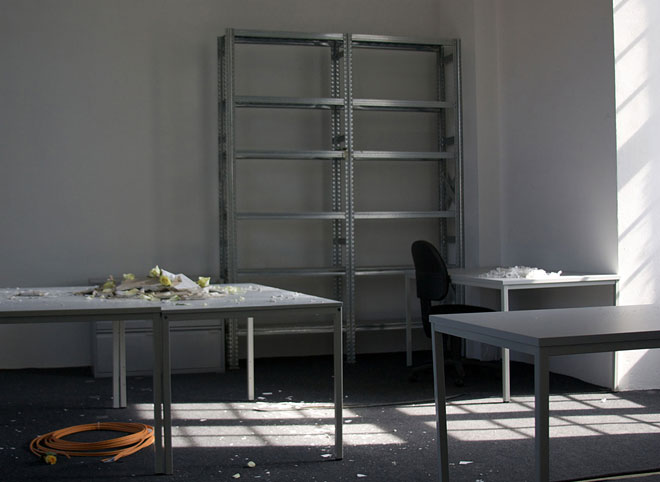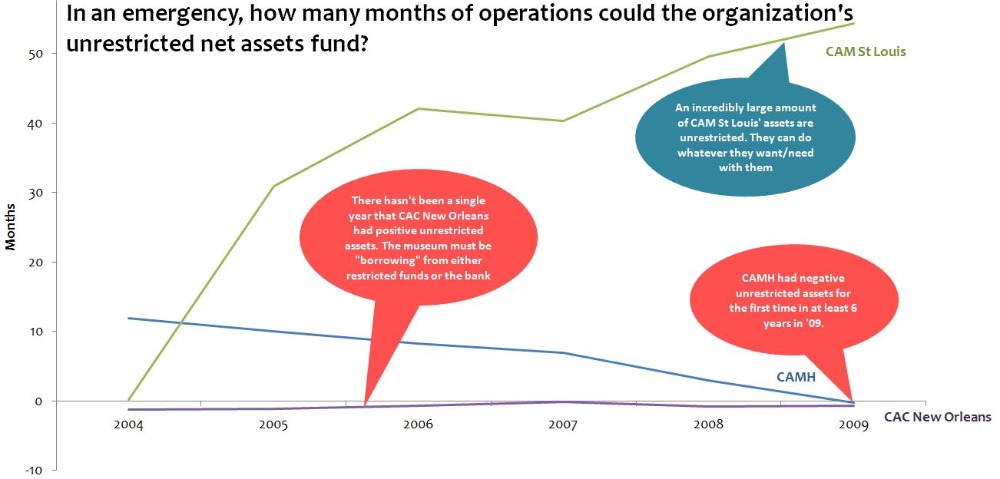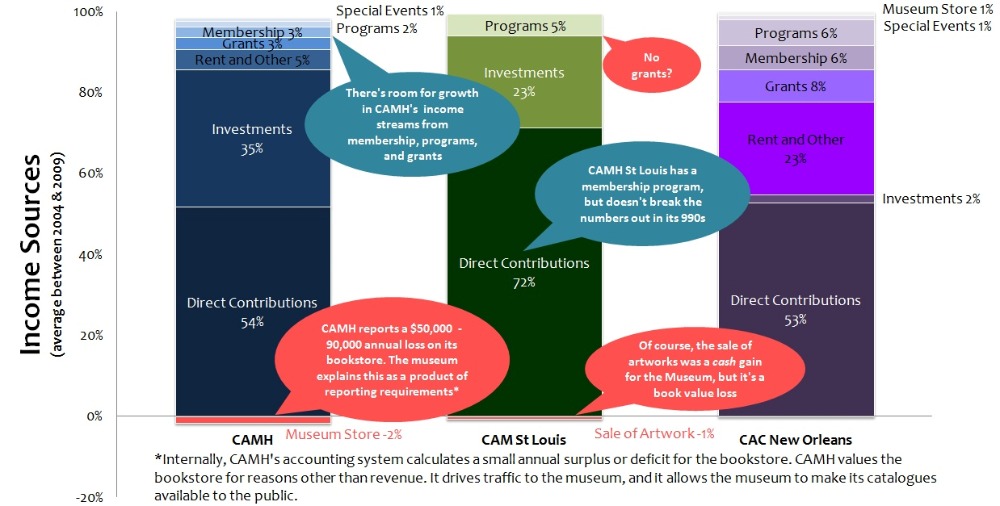About a year ago now, I published a series of articles introducing readers to some of the financial metrics consultants, academics, and others have used to evaluate the financial stability of nonprofits and applying these metrics to the nonprofit contemporary art world. I used a variety of case studies from mid-sized U.S. cities (Crunching the Numbers Part I: Arthouse, Dallas Contemporary, and San Jose ICA, Part II: Austin Museum of Art, Tucson Museum of Art, and MOCA Jacksonville, and Part III: CAM Houston, CAC New Orleans, and CAM St. Louis) to consider what these metrics could and couldn’t say, especially given the fact that the 990 data nonprofits file with the IRS is notoriously flawed and limited in scope.
At the time, I foregrounded Arthouse and the Austin Museum of Art in my analyses for obvious reasons: Arthouse was in dire financial straits after a recent capital campaign and expansion, AMOA had just sold its arts district property after years of thwarted attempts to build a new museum, and the two organizations had recently entered merger discussions. Six months later, the boards of both museums voted to officially approve a merger and began the search for a director to lead the new organization, AMOA-Arthouse. This week, the organization announced the appointment of Albright-Knox director Louis Grachos.
However, among all nine of the organizations I considered, CAC New Orleans stood out for the dangerous picture painted by its financial data. At the time, I literally wrote that the CAC’s numbers “freak me out.” Looking back at the numbers I crunched then (N.B. click on the figures for full-size versions; figures are from my original article, where they are explained in much greater detail):
The organization reported negative unrestricted net assets every year between 2004 and 2009 (i.e. they were borrowing from themselves to fund operations) …
…and had neither the kind of revenue from investments nor the kind of revenue from public support sustaining other organizations of its size…
…and except in the two years post-Katrina, it only raised about $3 in public support for every $1 spent on fundraising. (That’s a net gain of $2, which by itself isn’t necessarily worrying, though it may buck the trend among peers. It could simply mean that development is eking every last dollar out of its public. But given the other evidence of mismanagement, it’s at least an open question whether development dollars were being well-spent.)
So, there were no surprises regarding the CAC’s particularly troubling financial situation when artists removed their work to protest an exhibition’s temporary closure for rental purposes and the director resigned last week, prompting Gambit’s thorough coverage of the signs of mismanagement that have been visible at the CAC over the past couple of years.
This crisis is only the latest in a long history of this type of financial trouble/possible mismanagement. Nonetheless, it never ceases to amaze how long arts organizations sputter along on deficits, losing good curators and staff to poor communication or broken promises, before a crisis hits the news and the board steps in to undertake drastic organizational transformation. Why do some organizations wait so long to change course? I see a few reasons for this, chiefly: (1) the difficulty of judging financial well-being when funding comes in big chunks, sporadic chunks, (2) the costs of staff turnover, (3) lack of knowledge and/or negligence, (4) attachment.
The Difficulty of Judging Financial Well-Being
One good year of fundraising followed by a couple of years of small deficits during which the surplus is drawn down may be a completely reasonable way for an organization to operate. As a beloved mentor of mine at Yale, Stanley Garstka, always says, in the nonprofit world, “funding is lumpy!” You get a big chunk here, live on that for a while, and another big chunk over there. Knowing this, the board may wait it out through a few years of deficit, maybe even three or four, before setting the wheels in motion to change course.
The Costs of Turnover
(More on this in a forthcoming post.) The costs of dismissing the director or other high-level managers and searching for replacements are numerous and high. Briefly, beyond the money spent on the search and the fundraising revenue lost through a leadership change, there are plenty of social costs associated with a leadership change. Boards are loath to initiate these processes with directors, and directors sometimes shy away from the same with their reports. Art spaces often retain a family-like vibe, and employees can be extremely close-knit (it’s one of the ways cultural workers are non-monetarily “compensated” for their work). In some cases, directors may shy from disturbing this cozy equilibrium with difficult feedback in performance reviews and the possibility that you or your friend at the desk next to you could be dismissed. Similarly, a director and her board run in the same social circles, more often than not, and this makes initiating changes in leadership uncomfortable. What’s more, the board is compensated only through social and cultural capital. It’s these kinds of rewards–the friendship of fellow board members, the feel-good nature of the work–that come under threat when board members push back against the path of least resistance.
Lack of Knowledge/Negligence
I can think of at least three cases in which board members I’ve spoken with during and after executive leadership crises have said, “we had no idea.” In these cases, my sense is that the executive directors weren’t actively lying to their boards. Rather, the directors themselves did not realize the gravity of the situation, and, like their boards, kept hoping that soon something would come along to fix it. The boards trusted their directors, of course, and the structures and processes by which they oversaw the organization’s finances were not sufficient, or a critical board member or two was willing to write a check at the end of the year to smooth over whatever shortfalls their were, few questions asked.
Attachment
The simple truth is: we cultural workers and supporters become very attached to particular art spaces in a deeply personal way. We want them to be ours. We love them. We hate them. We wish they were more like we remember them in the old days. We wish they would change. They represent our communities, they provide infrastructure for our work, they present opportunities for edification and pleasure. Emotional attachment is critical to the formation of real community, the engagement in real dialogue, the commitment to big dreams. Sometimes though, emotional attachment makes the processes of decision-making and change cumbersome and slow. It can allow us to ignore real signs that an organization needs drastic intervention, and thus another organization falls into the fire.
A good thing about fire is the speed of action it impels.
In my first post in quite a while, thank you to Kate Garroway, with whom I’ve had countless conversations about all things nonprofit finance and strategy over the past two years.







3 comments
When you consider reason 4, attachment, I think there are a lot of complicated things going on. One is not so much love for the troubled institution but an inability to imagine a different situation–in short, inertia. I think the default position is inertia, followed distantly by heroic actions to save a troubled institution. But almost never on anyone’s radar is an orderly end. There are not obvious roadmaps about how to wind-down and liquidate an institution–even though this is often what is needed. Instead, we allow these institutions to crash and burn.
So boards need to know how to recognize that the non-existence of their institution might be preferable to limping onward indefinitely. And they need to know how, once they have made a decision to pull the plug, to do so in the least destructive way possible.
Great piece, Claire, both the original and the follow up on the CAC! Q: Would it be possible to correct the heading on the original piece which ends “This final article considers the Contemporary Art Museum Houston (CAMH) alongside the Contemporary Art Museum St. Louis (CAM St. Louis) and the Contemporary Art Museum St. Louis (CAC New Orleans).”
Here in Nola it is widely believed that the CAC New Orleans is not in St. Louis. Thanks again for your very helpful and insightful, much appreciated. Eric Bookhardt
Fixed! Thanks for the heads up on that rather large typo. Apologies for relocating an entire arts organization.